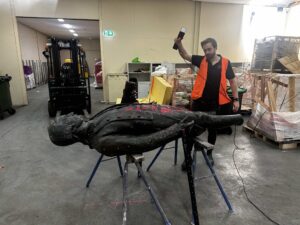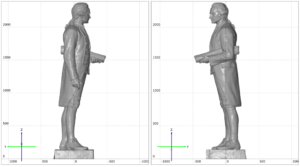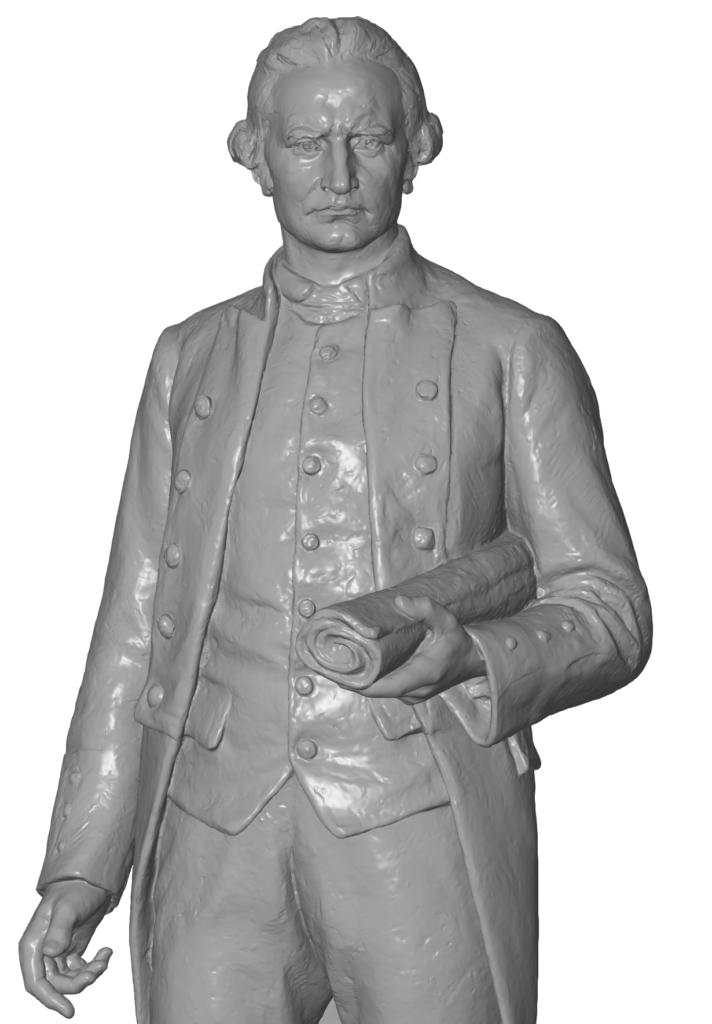
20 Nov Historical Archiving of Captain Cook Statue Through 3D Scanning
Background
In a project led by the City of Port Phillip and Meridian Sculpture; Scan-Xpress was commissioned to perform a high-precision 3D scan of the recently restored Captain Cook statue, a historic monument representing one of the most prominent figures in Australia’s colonial history. Originally installed in 1914, the statue of Captain James Cook, a famed British explorer and navigator, has become an enduring feature of the City of Port Phillip’s heritage landscape. Restoration efforts were undertaken to preserve the statue’s structural integrity and visual detail for future generations.
Objective
The primary objective of the 3D scanning project was to create an accurate, high-resolution digital twin of the Captain Cook statue. This digital model would serve as a valuable historical record and facilitate future restoration, replication and educational initiatives. High-precision 3D scanning provides an invaluable means of documentation by capturing every detail of the statue’s complex surface geometry, ensuring its preservation in digital form.Equipment and Technology
To achieve optimal results for this challenging outdoor task, Scan-Xpress utilised the ZEISS T-SCAN Hawk 2, a state-of-the-art handheld 3D scanner selected for its portability, accuracy and suitability for outdoor use, especially under direct sunlight. The scanner’s Satellite Mode was employed first to establish control points and anchor the scan over the full height of the statue, which would help maintain accuracy over the entire surface area before high-resolution scanning began. The T-SCAN Hawk 2 is equipped with advanced blue laser technology, enhancing its capacity to scan reflective or challenging surfaces, often found in weathered bronze and metallic statues. This also enables effective data collection without the need for controlled lighting setups. Its lightweight and ergonomic design allowed Application Engineer, Josh Span to easily navigate around the statue, capturing data from various angles to construct a complete digital model with high accuracy. Additionally, the T-SCAN Hawk 2’s data acquisition speed was critical for efficiently capturing the extensive details of the statue while minimising on-site time.Process and Execution
 The scanning process commenced with a preliminary assessment of the statue to identify optimal scanning angles and surface conditions. Josh utilised a series of systematic passes around the statue, ensuring comprehensive coverage of both broad surfaces and intricate details, such as facial features and clothing textures. This meticulous approach allowed for the capture of the statue’s nuanced artistry and surface wear patterns, which are critical for both historical records and any future restoration efforts.
Once the scanning was complete, the raw data was processed using ZEISS INSPECT to produce a high-fidelity 3D model. This model was then reviewed to ensure that all aspects of the statue were accurately represented, with particular attention to fine details.
The scanning process commenced with a preliminary assessment of the statue to identify optimal scanning angles and surface conditions. Josh utilised a series of systematic passes around the statue, ensuring comprehensive coverage of both broad surfaces and intricate details, such as facial features and clothing textures. This meticulous approach allowed for the capture of the statue’s nuanced artistry and surface wear patterns, which are critical for both historical records and any future restoration efforts.
Once the scanning was complete, the raw data was processed using ZEISS INSPECT to produce a high-fidelity 3D model. This model was then reviewed to ensure that all aspects of the statue were accurately represented, with particular attention to fine details.
Outcomes and Impact

 The 3D scan of the Captain Cook statue produced a highly accurate, scalable digital model suitable for archiving purposes. By completing this project, Scan-Xpress has contributed to the long-term preservation of a culturally significant artifact, offering the City of Port Phillip and future generations a durable record of this important monument. The use of T-SCAN Hawk 2 highlights the impact of modern engineering tools in heritage conservation, where precision and adaptability play a crucial role in historical preservation.
This project not only illustrates the technical capabilities of portable 3D scanning technologies but also demonstrates their increasing relevance in cultural heritage management, where accuracy and archival-quality records are essential for on-going conservation efforts.
The resulting 3D model serves as a precise digital twin, capturing the statue’s detailed geometry and unique characteristics. This model can now be stored indefinitely, providing the City of Port Phillip with a valuable resource for future restoration, virtual display and public education.
The 3D scan of the Captain Cook statue produced a highly accurate, scalable digital model suitable for archiving purposes. By completing this project, Scan-Xpress has contributed to the long-term preservation of a culturally significant artifact, offering the City of Port Phillip and future generations a durable record of this important monument. The use of T-SCAN Hawk 2 highlights the impact of modern engineering tools in heritage conservation, where precision and adaptability play a crucial role in historical preservation.
This project not only illustrates the technical capabilities of portable 3D scanning technologies but also demonstrates their increasing relevance in cultural heritage management, where accuracy and archival-quality records are essential for on-going conservation efforts.
The resulting 3D model serves as a precise digital twin, capturing the statue’s detailed geometry and unique characteristics. This model can now be stored indefinitely, providing the City of Port Phillip with a valuable resource for future restoration, virtual display and public education.
Interested in reading about our next projects and company news?
Subscribe


